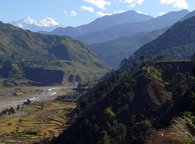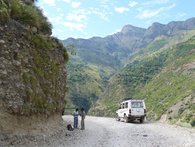Quantifying the Response of Rapidly Eroding Landscapes to Climate Change with Cosmogenic Nuclides | QUARREL
In many regions on Earth, Global Warming and the associated changes in the hydrological cycle affect total river runoff and the frequency and magnitude of floods. Changes in discharge are likely to immediately affect the transport capacity of rivers, but how climatic changes affect the supply of sediments from hilllopes is not well understood. In this project, we measure cosmogenic nuclide concentrations in fill terraces of the Yamuna River, India, to determine the temporal variability of hillslope erosion rates and to unravel how a rapidly eroding landscape in the Himalaya has responded to climatic changes in the past. We will supplement our geochemical approach with a reconstruction of the geometry and volume of the valley fill, based on field mapping and topographic modeling. Furthermore, we will use different geochronological methods to obtain an accurate chronology of the aggradation-and-incision cycle, and combine these data with sedimentological observations for inferring the source and origin of the sediments. The expected results of this project will help assessing the impacts of present-day climate change, and evaluating the consequences of Quaternary climate fluctuations for erosion in the Himalaya and the postulated feedbacks on Late Cenozoic climate change.
Project members
- René Kapannusch, ehem. GFZ Section 3.3: Earth Surface Geochemistry, PhD student
- Prof. Dr. Dirk Scherler, GFZ Section 3.3: Earth Surface Geochemistry
- Dr. Hella Wittmann-Oelze, GFZ Section 3.3: Earth Surface Geochemistry
- Prof. Dr. Sanjay Kumar Mandal, IISER Kolkata
Kooperationspartner
- Prof. Dr. Georgina King, Institute of Earth Surface Dynamics, Université de Lausanne, Lausanne, Switzerland
- Dr. Jason B. Barnes, Landscape Analytics LLC, Seattle, WA, USA
- Prof. Dr. Nadja Insel, Department of Earth Science, Northeastern Illinois University, Chicago, IL, USA
- Prof. Dr. Alexander L. Densmore, Department of Geography, Institute of Hazard, Risk, and Resilience, Durham University, Durham, UK
Time frame
- 2016 – 2020
Funding
- Funded by Deutsche Forschungsgemeinschaft (SCHE 1676/3-1)
Publications
Scherler, D., Bookhagen, B., Wulf, H., Preusser, F., Strecker, M.R. (2015): Increased late Pleistocene erosion rates during fluvial aggradation in the Garhwal Himalaya, northern India. Earth and Planetary Science Letters, vol. 428, p. 255-266, https://doi.org/10.1016/j.epsl.2015.06.034.
Kapannusch, R., Scherler, D., King, G., Wittmann, H. (2020): Glacial influence on late Pleistocene 10Be-derived paleo-erosion rates in the north-western Himalaya, India. Earth and Planetary Science Letters, vol. 547, https://doi.org/10.1016/j.epsl.2020.116441.
Mandal, S. K., Kapannusch, R., Scherler, D., Barnes, J. B., Insel, N., & Densmore, A. L. (2023). Cosmogenic nuclide tracking of sediment recycling from a Frontal Siwalik range in the northwestern Himalaya. Journal of Geophysical Research: Earth Surface, vol. 128, e2023JF007164. https://doi.org/10.1029/2023JF007164.






